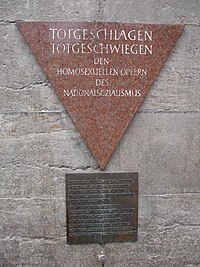Portal:LGBTQ/Selected article: Difference between revisions
m reword |
m sp |
||
| Line 2: | Line 2: | ||
Before the beginning of [[World War II]], [[Germany]] had a reputation as the one of the most liberal, gay-friendly cities in the world. However, upon the rise of [[Adolf Hitler]], [[gay]] men and, to a lesser extent, [[lesbians]], were two of several groups targeted by the [[Nazi party]]. Beginning in 1933, Organizations were banned, scholarly books about [[homosexuality]], and [[sexuality]] in general, were burned, and homosexuals within the Nazi party itself were murdered. The [[Gestapo]] compiled lists of homosexuals, and they were compelled to sexually conform to the German norm. More than one million homosexuals were targeted, and at least 100,000 were imprisoned. Estimated deaths of gay men imprisoned in [[concentration camp|concentration camps]] vary from 15,000 to 600,000. Homosexuals in camps were treated in an unusually cruel manner by their captors, and were also persecuted by their fellow inmates. This was a factor in the relatively high death rate for homosexuals, compared to other "anti-social groups". |
Before the beginning of [[World War II]], [[Germany]] had a reputation as the one of the most liberal, gay-friendly cities in the world. However, upon the rise of [[Adolf Hitler]], [[gay]] men and, to a lesser extent, [[lesbians]], were two of several groups targeted by the [[Nazi party]]. Beginning in 1933, Organizations were banned, scholarly books about [[homosexuality]], and [[sexuality]] in general, were burned, and homosexuals within the Nazi party itself were murdered. The [[Gestapo]] compiled lists of homosexuals, and they were compelled to sexually conform to the German norm. More than one million homosexuals were targeted, and at least 100,000 were imprisoned. Estimated deaths of gay men imprisoned in [[concentration camp|concentration camps]] vary from 15,000 to 600,000. Homosexuals in camps were treated in an unusually cruel manner by their captors, and were also persecuted by their fellow inmates. This was a factor in the relatively high death rate for homosexuals, compared to other "anti-social groups". |
||
After the war, the treatment of homosexuals in concentration camps went unacknowledged by most countries, and some men were even re-arrested and imprisoned based on evidence found during the Nazi years. It was not until the 1980s that governments acknowledged this |
After the war, the treatment of homosexuals in concentration camps went unacknowledged by most countries, and some men were even re-arrested and imprisoned based on evidence found during the Nazi years. It was not until the 1980s that governments acknowledged this episode, and not until 2002 that the German government apologized to the gay community. This period still provokes controversy, however; and in 2005, when the [[European Parliament]] drafted a resolution regarding the [[Holocaust]], mention of the [[persecution]] of homosexuals was excised after debate.<small>''''' [[History of homosexual people in Nazi Germany and the Holocaust| (...MORE)]]'''''</small> |
||
{{{Archive|<div style="text-align:right;">'''[[Portal:LGBT/Previous articles|...Archived articles]]'''</div>}}} |
{{{Archive|<div style="text-align:right;">'''[[Portal:LGBT/Previous articles|...Archived articles]]'''</div>}}} |
||
Revision as of 11:16, 16 January 2007

Before the beginning of World War II, Germany had a reputation as the one of the most liberal, gay-friendly cities in the world. However, upon the rise of Adolf Hitler, gay men and, to a lesser extent, lesbians, were two of several groups targeted by the Nazi party. Beginning in 1933, Organizations were banned, scholarly books about homosexuality, and sexuality in general, were burned, and homosexuals within the Nazi party itself were murdered. The Gestapo compiled lists of homosexuals, and they were compelled to sexually conform to the German norm. More than one million homosexuals were targeted, and at least 100,000 were imprisoned. Estimated deaths of gay men imprisoned in concentration camps vary from 15,000 to 600,000. Homosexuals in camps were treated in an unusually cruel manner by their captors, and were also persecuted by their fellow inmates. This was a factor in the relatively high death rate for homosexuals, compared to other "anti-social groups".
After the war, the treatment of homosexuals in concentration camps went unacknowledged by most countries, and some men were even re-arrested and imprisoned based on evidence found during the Nazi years. It was not until the 1980s that governments acknowledged this episode, and not until 2002 that the German government apologized to the gay community. This period still provokes controversy, however; and in 2005, when the European Parliament drafted a resolution regarding the Holocaust, mention of the persecution of homosexuals was excised after debate. (...MORE)
